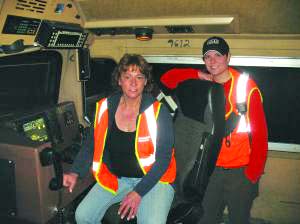
21 February 2011
Riding the Rails

|
Pat Filkowski-Jones (left) started her Canadian Pacific career as a freight clerk, but now
she's at the throttle when some of those freight trains pull out of Lethbridge. She's joined by Elizabeth Lawrence, one of several Lethbridge-area women who
work as conductors on those trains. |

Lethbridge Alberta - When Pat and Elizabeth hit the road, they're not stopping for coffee or
gasoline. And they're not watching for the highway patrol.
Instead, they're guiding thousands of tonnes of cargo up the Crowsnest Pass. Or taking the scenic route to Calgary.
But they're not steering. Instead, they're responsible for Canadian Pacific trains leaving Lethbridge and they're among a growing number of women who've
advanced their careers in what's been traditionally an all-male domain.
Pat Filkowski-Jones is a railway engineer, at the throttle of mighty diesels with thousands of horsepower. Elizabeth Lawrence is a conductor, responsible for
communication, documentation, and all the logistics of today's on-the-road rail operations.
Earlier this winter, the two Lethbridge women became the first all-female crew to pilot a train from here to the bustling Alyth yard in Calgary. Working out of
Calgary the national railway's headquarters there's a growing number of women driving trains.
And while plenty of women hold desk jobs with the railway, Filkowski-Jones says there's nothing like that kind of daily routine when you're in the
"running trades."
"Something different happens every time," she says, looking back on better than a decade on the rails. Like Lawrence, she trained first as a
conductor after more than 15 years of clerical work, initially at the CPR station downtown and then at the relocated rail yard at Kipp.
Conductors and engineers are trained in Lethbridge, in other railway hubs across Canada, and at a special facility operated by the Southern Alberta Institute
of Technology in Calgary. Then there's learning on the job, as the third member of what's usually a two-person crew.
With cabooses sidetracked these days, conductors like Lawrence ride in the locomotive where trainees quickly see how many tasks are involved in powering a
train from one city to another. On some, like potash trains heading to the West Coast, it's basically an uphill grind.
By comparison, Filkowski-Jones says, on the run south to the U.S. interchange at Coutts, crews face a series of hills and valleys that few motorists notice.
One of the challenges there is keeping under the posted speed, uphill and down, while dealing with the "slack" between one rail car and the next.
There's another challenge, documentation on every run.
"We have to know what's in every car," says Filkowski-Joness says.
If there's a regulated or hazardous commodity onboard, crews have to know that, too. And so much more.
"There's a lot of paperwork," says Lawrence, and as a conductor she's working with the train orders, what's the schedule, where are there other
trains to wait for, or pass, where do cars get dropped off or picked up, as well as print-outs for every part of the train.
Today's trains have radio communication, of course, but there are still signal lights, fault detection units, and on-board gauges to monitor. And when trains
are being marshalled at Kipp, or there are cars to "spot"along the line, it's still the conductor's job to climb down, throw the switch, and guide
the engineer.
Railroads run around the clock, so some of those trips start long before sunrise. From Lethbridge, crews also head east to Medicine Hat or simply across the
Lethbridge viaduct to serve the industrial park as well as to points north, south, and west.
But day or night, high above the tracks, Lawrence says there's always something that catches the eye.
"You see wildlife everywhere," Lawrence says. "We see a lot of things that most people don't."
But there's always something new. For Filkowski-Jones, it was an opportunity to pilot CP's famous "Royal Canadian Pacific," featuring restored luxury
passenger cars from the 1930s, en route to Calgary.
"I actually drove the passenger train on my birthday," an unintentional gift.
Those shared experiences everything from winter storms to steam engine tours are part of what makes "working on the railway" as unique a career today
as when the first trains conquered the Rockies 125 years ago.
"You get to know a lot about your co-workers," says Lawrence.
Agrees Filkowski-Jones, "It's like your other family."
Dave Mabell.

|


